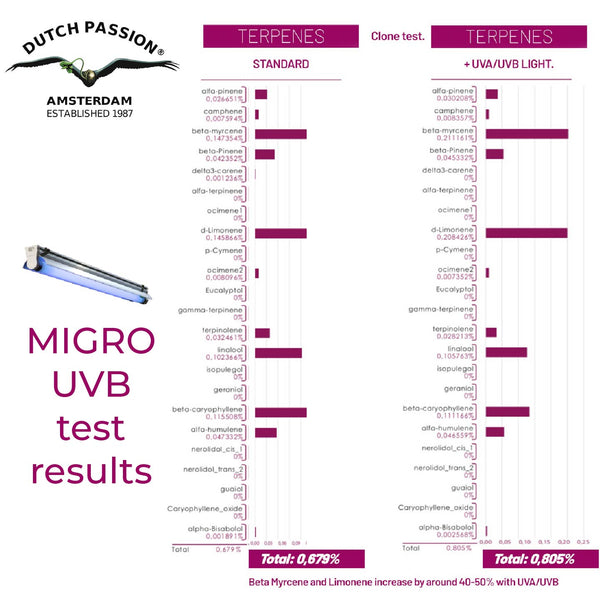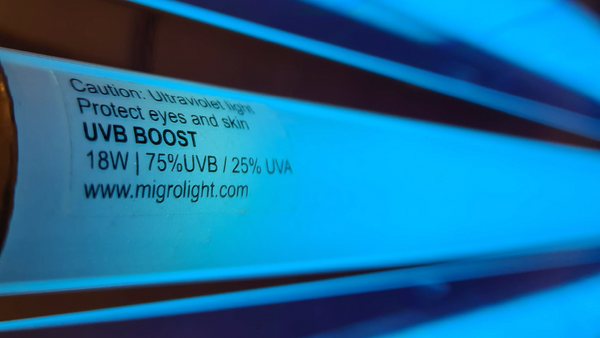UV grow lights are used to improve the taste and smell of your medicinal herb harvest. It is UVB, not UVA, that causes the 'sunscreen effect' where plants generate oils containing flavonoids and terpenes to protect itself. UVB cannot be generated by LEDs or HID lights, only with fluorescent UV grow lights.
How Does UV Light Affect Plants?
UV radiation is present in sunshine but not emitted by most grow lights. UVB is necessary to improve harvest quality. Some grow lights emit a small amount of UVA such as Metal Halide and UVA LEDs but not UVB. UVB LEDs are not effective but UVB fluorescents are a high efficiency source of UVB and UVA for supplemental plant lighting.
UV increases the flavour and taste of the harvest
UV grow lights emitting UVB increase production of secondary metabolites by up to 40%. Secondary metabolites in the form of Flavonoids and Terpenes to improve taste and smell of your harvest. The entourage effect is Flavonoids and Terpenes act synergistically with THC to increase the overall psychoactive effects of the plant.
We conducted a test in partnership with Dutch Passion seeds and there was a 19% increase in Terpenes recorded with one strain using the MIGRO UVB 310 at the flowering stage. See the results in our Blog post here.

UV prevents pest infestation and disease
UV grow lights that output UVA increase cell wall thickness and health, making the plant more resilient against pests, mold, and mildew.
What is UV Light?
Often referred to as UV light for short, ultraviolet light is technically a part of the electromagnetic radiation present in natural sunlight. Every time you are out in the sun, you are exposed to UV light.

It is broken up into three different categories of wavelengths - UVA, UVB, and UVC. It helps plants grow in several ways and also may improve the overall potency and quality of your flower. But, only certain types of UV light are really beneficial to plants.

The Different Types of UV Light
- Ultraviolet C (UVC)
UVC gets filtered out by the ozone layer, and never really makes it to the earths surface or to our outdoor plants. UVC is extremely dangerous to life and will damage cells causing living organisms to die under high exposure and can cause cancer.
- Ultraviolet A (UVA)
Ultraviolet A, or UVA light, is light with wavelengths between 320 nm and 400 nm. It contains about 3% of the photons that are found in natural sunlight when it breaks through the earth’s atmosphere. It does not have any harmful effects on DNA.
- Ultraviolet B (UVB)
The next type of ultraviolet light is UVB with wavelengths between 280 nm and 320 nm. It contains about a fifth of 1% of overall natural sunlight. In contrast to UVA, it can damage DNA and has been known to have cancerous effects on humans and animals.
Higher Flower Quality, Potency, & Weight
Studies have shown that UVA and UVB light can increase resins and oils in the form of secondary metabolites. In particular UVB can enhance the production of terpenes and flavonoids in plants. This means your flower will smell and taste better.
Increased Resistance To Pests & Disease
Growers notice an increased resistance to stress and disease when supplementing with UVA and UVB spectrums. Plants can produce up to 15 different variant defence proteins when they are exposed to UV light.
UVB light has the ability to destroy harmful microorganisms, particularly when the wavelengths are shorter than 300 nm. Not only that, but UV grow lights can increase your plants resistance to mildew, bacteria, insects, and fungi.
When Should You Give Plants UV Light?
To increase the production of secondary metabolites we recommend using the UV grow lights for up to 2 hours per light cycle in the last three weeks of flowering. It is sufficient to dose the plants for short periods to stimulate increased oil production.
To help prevent pest and disease it is recommended using the UV grow light right through the grow cycle. It will help prevent the occurrence of mildew, mould and will help eliminate pests.
How Much UV Light Do Plants Need?
With a high efficiency system light the MIGRO UVB 310 we recommend 1-2 watts of UV grow light per square foot of growing space or about 10 watts per square meter. This means for a 4'x4' tent, for example, you would be just fine with around 16 - 32 watts of UV lighting to yield the benefits.

How long to use UV grow lights
The benefit of adding UV to your grow is in the last three weeks of flowering. The aim is to stimulate your plants to product secondary metabolites to improve the harvest quality. We recommend using the MIGRO UVB grow light for 2 to 3 hours per day in the last three weeks of flowering at our recommended hanging height and coverage area.
Growers Need To Stay Safe While Using UV Light
While UV light may not be harmful to your plants it can be to you in the form of sunburn. We recommend you do not work underneath the UV light when powered on. If you have to work near the UV grow lights when on please protect your eyes by wearing protective eyewear. We also recommend wearing sleeves and gloves if you are going to be working around your UV grow lights for more than a few minutes.
Why are UV LEDs not effective?
UV LEDs do not yet have the power to deliver the UVB intensity required to effect your harvest quality in a cost effective way. Fluorescent fixtures with special glass tubes and raw aluminium reflectors are required to deliver high UVB intensity efficiently.
The MIGRO UVB 310 delivers 75% UVB and 25% UVA in its spectrum output. A perfect blend to improve the production of secondary metabolites such as flavonoids and terpenes which improve the quality and taste of your medicinal herbs.

















1 thought on “Best UV grow light for indoor plants”
Aaron Syrmopoulos
I was looking to buy your UVB light but either your Black Friday sale ended early or I missed something (could be a timezone issue). Any chance you’ll have a Cyber Monday sale or I could get a discount code? Happy Holidays!!